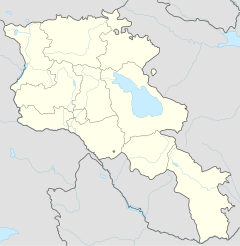
Back كاتدرائية إتشميادزينه Arabic كاتدرائيه اتشميادزينه ARZ Surp Mayr Tajar (Echmiatsin) AVK Üçkilsə kafedralı Azerbaijani Эчміядзінскі кафедральны сабор Byelorussian Ечмиадзинска катедрала Bulgarian Catedral d'Edjmiatsín Catalan Ečmiadzinská katedrála Czech Ejmiatsin Katedral Danish Kathedrale von Etschmiadsin German
| Etchmiadzin Cathedral | |
|---|---|
 | |
| Religion | |
| Affiliation | Armenian Apostolic Church |
| Rite | Armenian |
| Leadership | Catholicos of All Armenians |
| Status | Active, under renovation |
| Location | |
| Location | Vagharshapat, Armavir Province, Armenia |
| Geographic coordinates | 40°9′42.7″N 44°17′27.6″E / 40.161861°N 44.291000°E |
| Architecture | |
| Type | Cathedral |
| Style | Armenian |
| Founder | Gregory the Illuminator (original) |
| Groundbreaking | 301 (original building; traditional date)[1] |
| Completed | 303 (original building; traditional date)[1] |
| Specifications | |
| Length | 33 m (108 ft)[2] |
| Width | 30 m (98 ft)[2] |
| Dome height (outer) | 34 m (112 ft)[6] |
| Official name: Cathedral and Churches of Echmiatsin and the Archaeological Site of Zvartnots | |
| Type | Cultural |
| Criteria | (ii) (iii) |
| Designated | 2000 (24th session) |
| Reference no. | 1011-001 |
| Region | Western Asia |
Etchmiadzin Cathedral[a] (Armenian: Էջմիածնի մայր տաճար, romanized: Ēǰmiaçni mayr tač̣ar) is the mother church of the Armenian Apostolic Church, located in the city dually known as Etchmiadzin (Ejmiatsin) and Vagharshapat, Armenia.[b] It is usually considered the first cathedral built in ancient Armenia, and often regarded the oldest cathedral in the world.
The original church was built in the early fourth century[12]—between 301 and 303 according to tradition—by Armenia's patron saint Gregory the Illuminator, following the adoption of Christianity as a state religion by King Tiridates III. It was built over a pagan temple, symbolizing the conversion from paganism to Christianity. The core of the current building was built in 483/4 by Vahan Mamikonian after the cathedral was severely damaged in a Persian invasion. From its foundation until the second half of the fifth century, Etchmiadzin was the seat of the Catholicos, the supreme head of the Armenian Church.
Although never losing its significance, the cathedral subsequently suffered centuries of virtual neglect. In 1441 it was restored as catholicosate and remains as such to this day.[13] Since then the Mother See of Holy Etchmiadzin has been the administrative headquarters of the Armenian Church. Etchmiadzin was plundered by Shah Abbas I of Persia in 1604, when relics and stones were taken out of the cathedral to New Julfa in an effort to undermine Armenians' attachment to their land. Since then the cathedral has undergone a number of renovations. Belfries were added in the latter half of the seventeenth century and in 1868 a sacristy (museum and room of relics) was constructed at the cathedral's east end.[2] Today, it incorporates styles of different periods of Armenian architecture. Diminished during the early Soviet period, Etchmiadzin revived again in the second half of the twentieth century, and under independent Armenia.[2]
As the center of Armenian Christianity, Etchmiadzin has been an important location in Armenia not only religiously, but also politically and culturally.[14] A major pilgrimage site, it is one of the most visited places in the country.[15] Along with several important early medieval churches located nearby, the cathedral was listed as a World Heritage Site by UNESCO in 2000.
- ^ a b Sahinian, Zarian & Ghazarian 1978, p. 71.
- ^ a b c d e f g h Cite error: The named reference
Hewsenwas invoked but never defined (see the help page). - ^ Hasratyan 2003, p. 271.
- ^ Cite error: The named reference
Melik-Bakhshyanwas invoked but never defined (see the help page). - ^ Arakelian et al. 1984, p. 572.
- ^ Khachatryan 2020, pp. 85–86.
- ^ Azadian, Edmond Y. (1999). History on the Move: Views, Interviews and Essays on Armenian Issues. Detroit: Wayne State University Press. p. 211. ISBN 978-0-8143-2916-0.
- ^ Melton, J. Gordon; Baumann, Martin, eds. (2010). Religions of the World: A Comprehensive Encyclopedia of Beliefs and Practices (2nd ed.). Santa Barbara, California: ABC-CLIO. p. 186. ISBN 978-1-59884-204-3.
- ^ "Ejmiatsin". Encyclopædia Britannica. Archived from the original on 4 April 2014.
- ^ Adalian 2010, p. 297.
- ^ "Պատմաաշխարհագրական ակնարկ [Historical-geographic overview]" (in Armenian). Armavir Province: Armenian Ministry of Territorial Administration. Archived from the original on 28 February 2014. Retrieved 15 April 2014.
...Վաղարշապատ (1945–1995թթ. կոչվել է Էջմիածին) քաղաքը...
- ^ Arakelian et al. 1984, p. 571.
- ^ Adalian 2010, p. 128.
- ^ Jaloyan, Vardan. "Էջմիածնի կաթողիկոսության հիմնադրման քաղաքական և աստվածաբանական հանգամանքները [Theological and political circumstances of the foundation of the Etchmiadzin Catholicosate]" (in Armenian). Religions in Armenia. Archived from the original on 11 April 2014. Retrieved 11 April 2014.
- ^ "The number of foreign tourists visiting Armenia expected to surge to one million". ARKA News Agency. 30 June 2014. Archived from the original on 13 January 2015. Retrieved 12 January 2015.
Foreign tourists usually visit the pagan temple of Garni, Geghard Monastery, Holy Etchmiadzin and Lake Sevan.
Cite error: There are <ref group=lower-alpha> tags or {{efn}} templates on this page, but the references will not show without a {{reflist|group=lower-alpha}} template or {{notelist}} template (see the help page).
© MMXXIII Rich X Search. We shall prevail. All rights reserved. Rich X Search
